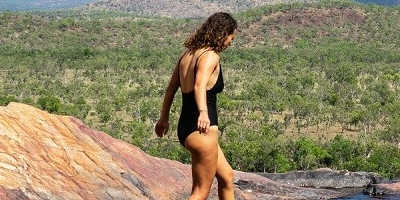Guide to Kakadu National Park
Kakadu, Northern Territory 0822
Kakadu National Park is a sprawling nature reserve that boasts a collection of diverse and beautiful landscapes. Visitors can immerse themselves in a series of wetlands, rivers, and ancient sandstone escarpments in a region that’s rich in both stunning views and a fascinating heritage.
Proudly displaying the natural beauty of Australia’s Northern Territory, this 20 000 km² National Park is a great place for all who are looking to get in touch with nature. The park is divided into seven distinct eco-regions, from East Alligator to Nourlangie and Yellow Water, each region has its own unique features and natural attractions.
As well as more than 2,000 different plant species and hundreds of wildlife species, there is a massive amount of history and culture to soak up in the park. Centuries-old rock paintings adorn the soaring sandstone cliffs and sacred sites are scattered through the land.
The History of Kakadu

Kakadu National Park was first established in April 1979. The establishment of the region into a National Park was first suggested in 1965 when a cultural shift was occurring across Australia to recognise traditional owners and their land interests. At the same time there was a push for areas to be named as National Parks in order to preserve them for conservation. For over a decade, discussions continued with Aboriginal communities from the area and traditional owners about the declaration. It was during this time that the name Kakadu was first suggested as recognition of Gaagudju, a local Aboriginal language.
In 1975, the park was listed under the National Parks and Wildlife Conservation Act 1975 and, more recently in 2013, a culturally rich splash of woodland called Koongarra was added to the park.
However, Kakadu’s history extends back much further than 1965. The local Aboriginal people have been living on this land for over 65,000 years. They moved around the park’s land in response to changing seasons and their art and sacred sites teach us much about how their society operated and the ways in which they migrated throughout the parklands. According to local Indigenous stories, Kakadu has existed since the Creation Time, or the Beginning, when their creation ancestors travelled across the landscape. The Rainbow Serpent carved out the landscape for all creatures, and Namarrgon started the violent lightning storms that brings rain to the region each summer.
The Culture of Kakadu National Park
Kakadu is home to the oldest living culture on Earth. In the south live the Mungguy people, while the Bininj people live in the north. Many of the local Indigenous people live in the townships within the park while other live in more remote areas. Caring and understanding the land is fundamental in Aboriginal culture, and no matter where they live, the traditional owners have deep understanding and connection to land.
Within the park there are approximately 19 clan groups. Clans generally consist of two or more family groups sharing ownership of certain areas of land, these clan boundaries are passed down generations through the father. The clans within Kakadu have a complex kinship system that determines how individuals relate to each other. This kinship system dictates the ways in which individuals communicate and identify people as mothers, fathers, uncles, cousins, potential marriage partners, and so on. Kinship governs day-to-day communication in Mungguy and Bininj culture.
Tradition, responsibilities and culture are incredibly important to the Aboriginal people residing in Kakadu. This land has been theirs for thousands of years and you should respect their culture when visiting. Be sure to listen to tour leaders, or follow signage, to ensure you are not entering sacred or ceremonial sites, burial grounds, or someone’s home when in the park. Do not touch rock artwork you see and respect people’s privacy.
Before European settlement 12 languages were spoken in the Kakadu area, today only three are regularly spoken. Gun-djeihmi and Kun-winjku are spoken at the northern end of Kakadu and are regarded as dialects because speakers can understand each other. Jawoyn however is a separate language only spoken in the southern parts of the park. Though the Mungguy and Bininj people are happy to share their culture with non-Aboriginals, and welcome them to Kakadu, many stories and sites are only for the initiated and secrets must be respected.
Cultural Centres in Kakadu
Cultural centres are a great place to learn more about Kakadu and its cultural heritage before setting of on your journey. There are two cultural centres in the park, each teaching visitors about different things.
-
Warradjan Cultural Centre
The first stop for any Kakadu trip should be the Warradjan Cultural Centre. Here you will learn about the relationship between resident Aboriginal groups and the land around them. Developed and run by the park’s traditional owners, the centre is the perfect starting point for any visitor to Kakadu.
Learn more about local Aboriginal culture and traditions in their unique exhibitions. The Centre uses contemporary museum techniques, such as video and interactive exhibits, to display personal stories, traditions, bush tucker and more. Their ‘Our Land is Our Life’ exhibit details the ways in which hunting methods were altered depending on the season, the recent history of the park, blood lines and marriage rights, elder stories, and the impact of white settlement on culture and their land. Meanwhile the ‘Come Look and Feel Our Culture’ exhibit focusses on traditional owners and building understanding of connection to land and their country.
-
Bowali Visitor Centre
The Warradjan Cultural Centre will teach you about the culture of Kakadu, the Bowali Visitor Centre will teach you about the landscape and wildlife. Designed to showcase both the Aboriginal and non-Aboriginal views of the park, it is hoped you leave the centre with a better understanding that we must look after the country of the Kakadu region.
Centre staff will help you plan walks and activities through the park, as well as answer any questions you may have about your time in Kakadu. Sit down and relax with a drink from the Anmak An-me Café and wander through the Marrawuddi Gallery which promotes Aboriginal fine art form Kakadu and surrounding regions.
Hit the Pools
Kakadu is renowned for its selection of pretty plunge pools that are perfect for cooling off in. The wet season brings an abundance of water that sees falls violently flowing and pools flooding over. As the dry season rolls in the pools and falls calm to become some of the best places to cool down in the days heat.
-
Jim Jim Falls
Jim Jim Falls is a popular place to go. These magnificent falls cascade down from a height of 200m and thunder into the plunge pool below. It’s only open during the region’s dry season, and it’s only reachable by four-wheel-drive, making it a little less crowded than some of the other spots in the park.
-
Twin Falls
Situated 10 km past Jim Jim Falls, the Twin Falls are entrenched in the Arnhem land escarpment and cast a pretty backdrop against the scenic walks surrounding the area. Two huge falls cascade 150m down the cliff face into a deep pool. During the dry season you can get right under the falls and swim in the pool below.
-
Maguk Gorge
A snorkellers dream, Maguk gorge is home to a vibrant array of marine life and is easily accessible for the less experienced adventurer. The water is jade green, with the high gorge sides providing shade over the water. Confident swimmers can swim to the far side of pool where the falls trickle in the dry season and provide swimmers with a great shoulder massage.
-
Gunlom Falls
Perhaps the most spectacular swimming spot in Kakadu, Gunlom Falls is the perfect place to cool down in the scorching heat. At the foot of the falls is a delightful large plunge pool, surrounded by serene bushland. For those spending an afternoon, take a short climb to the top of the waterfall where you will be gobsmacked by the panoramic views sweeping across the horizon. Slip into the natural infinity pool to refresh yourself, once you’ve cooled down, relax atop the warm boulders surrounding you.
Rock Art Galleries
The rock art in Kakadu National Park is of significant international and cultural significance. With paintings up to 20,000 years old these artworks are some of the longest historical records of any group of people on Earth. Paintings are a form of cultural expression and for the Bininj/Mungguy the act of painting is more important than the painting itself, meaning in some areas you can see layers of paintings.
Paintings allowed people to express their stories, and some paintings could only be painted by people with the right knowledge. For example, only those who held magical knowledge could paint about sorcery. The paintings in Kakadu share a fascinating history of Aboriginal life and society over thousands of years.
-
Burrungkuy (Nourlangie)
Aboriginal people lived here in the wet season, where they could harvest plants and hunt for goanna, fish, mussels and birds. The shelter kept them from getting wet, and the large flat rocks were used as grinding holes, likely used to prepare food and create ochres for painting. Here you will see paintings of creation ancestors including Namarrgon, the Lighting man.
-
Nanguluwurr
Just a 1.7km walk from Burrungkuy you’ll find Nanguluwurr. This small gallery contains depictions of ancestral beings and animals. You can see a range of art styles here, from hand stencils to x-ray art. One particularly fascinating piece is an early depiction of European contact, showing a sailing ship with two masts and anchor.
-
Ubirr
Perhaps the most well-known gallery in Kakadu, Ubirr is one of the reasons Kakadu National Park received a dual World Heritage listing for cultural significance. Here are fantastic examples of contact and x-ray art. Additionally a depiction of a thylacine (Tasmanian tiger) is found here, the animal is believed to have gone extinct on the Australian mainland 2,000 – 3,000 years ago. Creation ancestors, such as Rainbow Serpent can be found here too.
Wildlife in Kakadu
Kakadu is rich in native Australian wildlife, including endemic and rare species. Across each region you will find a new set of wildlife around you.
-
Termites
Visit the 6m high termite mounds in the Mary River Region. Made from mud and termite saliva the mounds are incredibly strong and can last up to 60 years. Inside each mound is a network of tunnels homing millions of termites. In addition to creating these awesome mounds, termites also help other species but eating the dead wood in the centre of trees and hollowing out trunks for other animals to live in.
-
Saltwater Crocodiles
Safely see these prehistoric beasts on a cruise in the East Alligator River region. Growing up to 6m in length, watch these ferocious creatures in their natural habitat, swimming and leaping from the water. Crocodiles mostly eat fish but have been known to eat large land animals such as cows and buffalo also! Be sure to keep an eye out for any crocodile warning signs and adhere to instructions to ensure you stay safe.
-
Black Wallaroo
This unique macropod is, as its name suggests, a mix between a wallaby and a kangaroo. Powerful and fast, the black wallaroo is perfectly built to blend in the shadows of the stone country. Living in the stone country means they rely on spinifex for food, a tough spikey grass that is indigestible by most other animals. You can often see these animals around Nourlangie.
Access to Kakadu National Park
Before booking your trip to Kakadu National Park it is important to do your research. Kakadu’s traditional owners recognise six seasons within the park, however commonly the seasons are referred to as the wet season or the dry season.
Much of the park is not accessible during the wet season due to flooding, so be sure to check if the areas you want to visit are open during the time of year, you’re planning to take your trip. Kakadu National Park is Aboriginal land and has been leased to the Director of National Park. Today it is managed by the traditional owners in partnership with Parks Australia. Additionally, visitors need a Kakadu Pass to enter the park, you may also require a permit to visit certain areas. Book ahead online to ensure you can visit the areas you want to.
Kakadu National Park is one of Australia’s most culturally rich regions. You’ll never forget your visit to this truly spectacular area. Soak in Indigenous culture and breathe in the fresh air of rural Australia. There’s nothing like Kakadu National Park anywhere in the world, so don’t miss your chance to visit!




